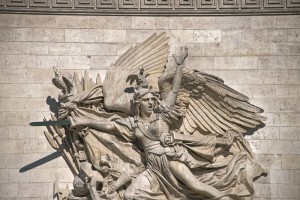To Arms!
French sculptor François Rude (1784-1855) was awarded the commission of the high relief that became known as The Departure of the Volunteers of 1792 ; on one of right face of the arc de triomphe de l’Étoile on the Champs-Élysées facing side. Just as for the song written by Rouget de Lisle, this masterwork was renamed La Marseillaise. The sculptor associated varied elements and influences of sculpture throughout the ages : Antiquity, Renaissance, XVIIth century… His work summed up the Western tradition of sculpture and created a new style that significantly influenced succeeding generations of French artists such as Carpeaux, Rodin and Bourdelle.
The 157 meters long and 2 meters high frieze at the top of the Arc is divided into two scenes depicting The Departure of the Armies and The Return of the Armies, with at their centre a distinct scene dedicated to the Glory of the Nation. This masterpiece was produced by six artists who each worked on an equal distribution of surface unit. On top of the high relief depicting The Departure of the Volunteers of 1792, known as La Marseillaise, Rouget de Lisle is represented in company of French composer François-Joseph Gossec (1734-1829), dressed as contemporaries described him as he walked the streets of Choisy-le-Roi at the end of his life. Two signatures can be seen on this sculpture : on the lower right that of Charles-René Laitié (1782-1862), on the lower left that of Sylvestre Brun (1792-1855).





Ajouter un commentaire